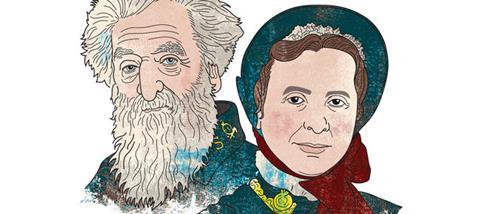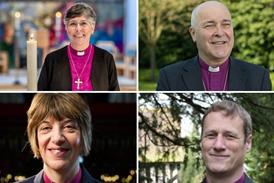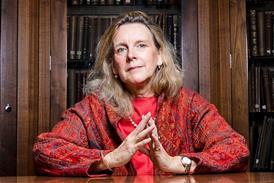
William Booth and Catherine Mumford were both born in 1829 in the north of England, but their childhoods were very different. By the time they were 14, Catherine had reputedly read the Bible twelve times, and enjoyed studying theology during her extensive leisure time; William was working as an apprentice pawnbroker to support his widowed mother and siblings. But when their paths crossed, they became one of the most formidable husband-andwife teams in Christian history.
Early years
Catherine had the benefit of Christian parents, a mother from the Puritan tradition and a father who was an occasional Methodist lay preacher before succumbing to alcoholism. William’s parents had him baptised, but that seems to have been the beginning and end of their interest in religion. When William became the head of the household at the age of 14, following his father’s death, he looked on track to follow the same path as his father – a life of constant struggle to put food on the table with little time for God.
That changed when a Wesleyan couple invited William to chapel. At the age of 15 he became a Christian, and started to see the poverty that surrounded him through a new lens: compassion. He realised that his profession preyed on people’s misfortune, but there were almost four years of his apprenticeship left to run. In the meantime, he became involved in lay preaching and open-air evangelism.
Laid off by his employer once he had finished his apprenticeship, William could not find work in Nottingham and moved in with his sister in London. Her alcoholic husband soon threw him out, and William was forced to take a job as a pawnbroker again, just to keep a roof over his head.
Meanwhile, after her quiet childhood in a small town in Derbyshire, Catherine’s family moved to London. A spinal curvature meant that Catherine had to spend much of her adolescence staying still, and she used the time to read theology.
How they met
In 1850 both Catherine and William were expelled, separately, from their churches for sympathising with the Methodist Reformers, who wanted to throw off Methodism’s new cloak of respectability, and reach those most in need again. Joining the Reformers, William met Edward Rabbits, a successful businessman, who was impressed by William’s talents and agreed to fund him as a paid preacher. This enabled William to leave pawnbroking, but Rabbits had an even more profound impact: he introduced William to Catherine, who by now was running a Methodist reform Bible class in Clapham. On William’s 23rd birthday, 10th April 1852, the ex-pawnbroker took Catherine home from a meeting and “fell over head and ears in love”. They got engaged the following month.
Their path to the altar was not straightforward. William felt that as a ‘hired preacher’ he was not free to follow whatever God called him to, but without a stable income, he could not support a wife. He tried different avenues, but did not find anything permanent that he could accept. Far from being impatient, Catherine encouraged William to stick to his principles.
Eventually, Rabbits came to the rescue again. William started training as a minister in the Methodist New Connexion, and Rabbits agreed to fund a new salaried post for the talented speaker. In 1855, the couple tied the knot.
The Salvation Army – a feminist movement?
From the outset, the Salvation Army made it a rule that women should not be prevented from holding any position of power. For single women, at least, there was absolute equality. (When two officers married, the woman was expected to resign her commission to support her husband.)
Catherine Booth strongly believed that women were called to exercise their gifts just as much as men, and that included preaching. She published a pamphlet, Female Ministry, arguing that biblical reasons for restricting women’s ministry were based on misinterpretation.
Catherine’s example of leadership inspired hundreds of young, working-class female officers, known as Hallelujah Lasses. The preponderance of women officers led William Booth to remark, “some of my best men are women!”
The next ten years were spent in itinerant ministry from Cornwall to Scotland, and having children; three sons and five daughters in total. Still, William was not content. Although he was offered a good post in Newcastle with the Connexion, he felt that pastoral duties did not allow enough time for evangelism. Once again, Catherine supported him, and William became an independent evangelist.
Catherine, meanwhile, had started preaching – an extremely unusual activity for a woman in the 19th century – and was invited to speak at Rotherhithe in London. She was appalled at the squalor she saw there, and started a Midnight Movement preaching to the prostitutes. She shared her concern for London’s underclass with William, who was equally moved. After years of wandering, he exclaimed, “Kate, I have found my destiny.” In fact, they both had.
Darkest England
It is hard to imagine the kind of poverty and degradation the Booths set out to conquer. This was the London of Charles Dickens and Jack the Ripper. A hundred thousand people in east London lived close to starvation, and countless others were driven to drink by their conditions. For the Booths, eternal salvation had to go hand in hand with meeting people’s practical needs. A loving God would not want people to suffer like this, and how could suffering people come to faith in a loving God?
While Catherine preached to wealthy donors, spreading awareness and raising funds, William started taking the gospel to pubs, music halls and street corners. Soon many expatrons of these establishments joined the mission to lead their friends and colleagues to God. They provided food for the hungry, shelter for the homeless, and an escape for women trapped in prostitution. It was a truly working-class movement, drawing its members from the poorest parts of society. William had got into trouble as a young man for bringing destitute men into a church service. Now he and Catherine had their own church designed for the lowest of the low – those who most needed help.
The organisation went through several name changes before settling, in 1878, on the ‘Salvation Army’ because of the disciplined commitment of members to saving souls. Soon the terminology of the whole organisation reflected an army, with ‘officers’ instead of clergy, and William in the role of general.
There was strong opposition to the new Army. Their populist methods, including using a brass band to draw a crowd, earned the scorn of newspaper editorials, but on the streets the opposition was more physical. Early Salvation Army evangelists regularly suffered injuries in the course of their work. Some were killed. Many of the victims of violence were young women still in their teens. These brave ‘Hallelujah Lasses’ were the backbone of the movement. They took the cause to new cities, and even new countries. (In the 1920s one of these young women, Rheba Crawford, was so effective in reaching out to the drunks and criminals of Manhattan that she was immortalised as Sergeant Sarah Brown in the musical Guys and Dolls.)
In their own words
“While women weep, as they do now, I’ll fight. While little children go hungry, as they do now, I’ll fight. While men go to prison, in and out, in and out, as they do now, I’ll fight. While there is a drunkard left, while there is a poor lost girl upon the streets, while there remains one dark soul without the light of God, I’ll fight – I’ll fight to the very end!”
"Secular music, do you say? Belongs to the devil, does it? Well, if it did, I would plunder him of it… Every note and every strain and every harmony is divine and belongs to us.”
“Work as if everything depended upon work and pray as if everything depended upon prayer.”
“I am not waiting for a move of God, I am a move of God!”
By 1890, opposition was dying down, but the Booth family still felt that not enough was being done for the most needy. The Salvation Army was becoming respectable and attracting a slightly better-off class of people, but the slums still resisted reformation. The ‘it’ book of that year was In Darkest Africa by the explorer Henry Morton Stanley. William, with the help of Catherine and journalist William Stead, published a response: In Darkest England and the Way Out. With dramatic imagery, he pointed out that while the natives of the African jungle might live in terrible conditions, the conditions of the poor in London were no better. Disease, starvation and slavery – in the form of prostitution – were just as common at home as in the ‘Dark Continent’.
Catherine died at the end of 1890, before she could see the book become a huge success, but her husband and her children carried on the work. By now many of the children were well-known preachers in their own right, and some led the Army’s work in new ‘territories’, or countries. But perhaps due to the loss of Catherine’s influence, William became increasingly dogmatic and inflexible. As a result, three of his eight children left the movement to found their own movements or become independent evangelists. The Army remained a family concern, however, with son Bramwell succeeding his father as general, and his sister Evangeline succeeding him in turn.
By the start of the 20th century, the Salvation Army had confounded its critics and become a respected institution. Its effectiveness was undeniable. Charles Spurgeon said, “If The Salvation Army were wiped out of London, five thousand extra policemen could not fill its place in the repression of crime and disorder.” In 1902, the triumph of the Booths’ movement was complete when William, aged 73, was invited to attend the coronation of a great admirer of his work, King Edward VII. In 1912, William finally followed his wife in being ‘promoted to glory’.
Karen Murdarasi is a freelance journalist




























